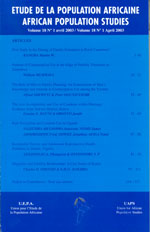
|
African Population Studies
Union for African Population Studies
ISSN: 0850-5780
Vol. 28, No. 2s, 2014, pp. 927-932
|
 Bioline Code: ep14038
Bioline Code: ep14038
Full paper language: English
Document type: Research Article
Document available free of charge
|
|
|
African Population Studies, Vol. 28, No. 2s, 2014, pp. 927-932
| en |
Demographic Transition in Morocco: an application of Easterlin-Crimmins’s model using DHS data
Ferrone, Lucia
Abstract
The aim of this study is to shed some light on the dynamics of fertility reduction in the MENA region, analyzing both proximate and latent fertility determinants: DHS data for Morocco from the 2004 round were hence used for this purpose. The main idea behind this application is that the key variable in fertility transition is contraception prevalence and use. The Easterlin-Crimmins method (1985) is a two-stage model of supply and demand. There are two endogenous variables: number of born children (B), and contraception use (U), while the exogenous ones are the costs of regulation, the demand for children, and the proximate determinants of fertility. Results show that contraception is, in fact, the key factor and determinant in fertility transition: ensuring access to contraception is therefore fundamental in reaching the final stage of the transition.
Keywords
Morocco; fertility; contraception
|
| |
| fr |
Ferrone, Lucia
Résumé
L'objectif de cette étude est de faire la lumière sur la dynamique de réduction de la fécondité dans la région
MENA, en analysant les déterminants de la fécondité à la fois immédiates et latente: données de l’EDS du
2004 pour le Maroc ont donc été utilisés à cette fin. L'idée principale derrière cette application est que la
variable clé dans la transition de la fécondité est la prévalence et l'utilisation de la contraception. La méthode
Easterlin-Crimmins (1985) est un modèle en deux étages de l'offre et de la demande. Il ya deux variables
endogènes: nombre d'enfants nés (B), et l'utilisation de la contraception (U), tandis que les exogènes sont les
coûts de la réglementation, la demande pour les enfants et les déterminants proches de la fécondité. Les
résultats montrent que la contraception est, en fait, le facteur clé et le principal déterminant de la transition
de la fécondité: assurer l'accès à la contraception est donc fondamentale pour atteindre la phase finale de la
transition.
Mots Clés
Maroc; fécondité; contraception
|
| |
© Copyright 2014 - African Population Studies
Alternative site location: http://www.uaps-uepa.org
|
|
